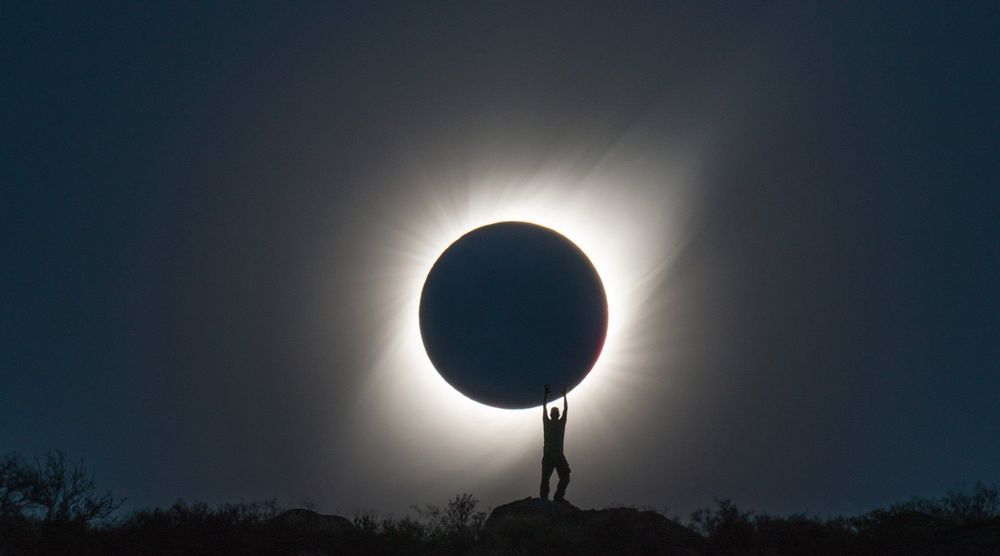Is freezing your way into the future a good idea — and is it even possible?



Photographer Albert Dros may have captured one of the coolest photos of yesterday’s total solar eclipse in Chile. In addition to a few striking photos of a his model, Bart Lablans, standing next to the eclipse, he also managed to capture Bart “holding” it at totality. Take that cliché Leaning Tower of Pisa photos.
The photo was captured as part of a group organized by Dream Photo Tours and NatPhoto. But instead of using this rare opportunity to capture a standard photo of the eclipse, Dros tells PetaPixel that he decided to get creative. “I decided to improvise a little bit on the spot and photograph a model doing some poses in front of the eclipse,” he tells us. “This was possible as there was a hill nearby that fit the angle of the eclipse perfectly.”
The resulting images were captured using a 100-400mm lens and 1.4x teleconverter, which allowed him to compress the background sufficiently to capture “both the moon and the person at a nice size in the frame.” After a little bit of additional cropping in post, here is what he ended up with:
(So far!)
Stem cell treatment offers hope for patients with Rheumatoid Arthritis.

A South Indian philosopher sometimes called the “second Buddha,” Nagarjuna stands ambivalently at the beginnings of Mahayana philosophy. His arguments are subtle, sophisticated, and complex. Their interpretation is made more difficult because they are written as beautifully crafted quatrains whose density require extra concentration. As a transitional thinker, Nagarjuna is taken by some commentators (David Kalupahana and Jay Garfield) as continuing the Pali tradition and by others (Frederick Streng and T. Wood) as making a clean break with it. The latter school of interpretation reads Nagarjuna’s quatrains as thoroughly dialectical refutations of any positive thesis, even the minimalist claims of Pali realism. There is general consensus that the Yogacara school of Vasubandhu and Asanga reject Nagarjuna’s views, whatever they are, in favor of an objective idealism roughly similar to Hegel’s. Unfortunately, we do not have space to deal with Yogacara except only in an indirect way.
As we have seen, Pali Buddhists do not deny the appearance of an empirical self (jiva); rather, they deny that, corresponding to this appearance, there is anything enduring, separate, or independent. These may just be three different ways of saying the same thing, but since they represent three different types of Buddhist arguments, they merit separate presentations. First, there is no self that endures. What we see is constantly changing and there is nothing that stays the same. The traditional argument here proceeds by elimination: the physical bodies change; feelings, beliefs, desires, and intentions all change; consciousness is intermittent; and our self-conceptions change over time. None of the things we can point to as the self remains the same. Therefore the self does not endure. The argument is similar to the one given by Hume.
Second, the self is not separate from the causes and conditions that give rise to it. A standard metaphor for this comes from the Dhammapada, a Pali text from the 3rd century BCE. The appearance of a rainbow arises out of a certain combination of mist and light. Remove either one of these and the rainbow no longer exists. Similarly, the appearance of a self arises out of conditions: oxygen, food, parents, etc. Without them, there would be no self. This argument can be made on a general level, as just done, or on a particular level. You wouldn’t be the person you are if your family, friends, and acquaintances all weren’t the people they are, if you hadn’t had the experiences you’ve had, lived in the society you live in, etc. If we define the constellation of these conditions as one’s “world,” we can say that the self cannot be separated, either practically or logically, from the world in which it exists.
Solar panels that don’t occupy valuable land.
Saving space whilst saving the planet.


For decades, slabs of crystalline silicon have dominated the solar industry. Other materials that can be layered in thin films, such as copper indium gallium selenide (CIGS) and cadmium telluride (CdTe), have captured less than 5% of the market, because it’s hard to make them as efficient or cheap as conventional solar panels. Perovskites could be a different story. They should be cheaper to make and seem impressively efficient at converting sunlight into electricity — in the laboratory, at least.
Companies say they are close to commercializing cheap perovskite films that could disrupt solar power — but are they too optimistic?